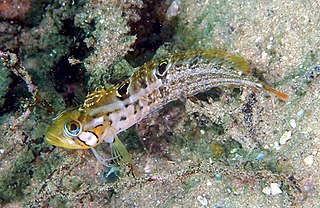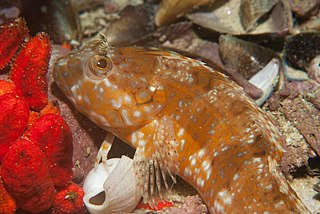
Clinus is a genus of clinids found in the southeastern Atlantic and western Indian ocean.

Omobranchus is a large genus of combtooth blennies found in the Pacific, Atlantic, and Indian oceans.
Blennophis is a genus of clinids found in the southeastern Atlantic ocean.
Clinoporus biporosus, the ladder klipfish, is a species of clinid found in subtropical waters of the Atlantic Ocean around the South African coast. It occurs in the subtidal zone down to a depth of 30 metres (98 ft). This species can reach a maximum length of 13 centimetres (5.1 in) TL. It is currently the only known member of the genus Clinoporus.
Blennioclinus brachycephalus, the Lace klipfish, is a species of clinid found in subtropical waters of the Atlantic Ocean around South Africa. This species can reach a maximum length of 15 centimetres (5.9 in) TL. This species primarily preys on benthic fauna including isopods, amphipods, and mollusks.
Blennophis anguillaris, the snaky klipfish, is a species of clinid found in the subtropical waters of the Atlantic Ocean around South Africa. It can be found in the subtidal zone and also is a denizen of tidepools. This species can reach a maximum length of 30 centimetres (12 in) TL.

Blennophis striatus, the Striped klipfish, is a species of clinid found in the subtropical waters of the Atlantic Ocean from Saldanha Bay to East London, South Africa where it can be found in the subtidal zone as well as inhabiting tidepools. This species can reach a maximum length of 17.5 centimetres (6.9 in) TL.

Clinus acuminatus, the sad klipfish, is a species of fish in the family Clinidae. It is endemic to Southern Africa, where it occurs along the coast of Namibia and South Africa. It can reach a maximum length of 13 centimetres (5.1 in) TL and is viviparous. The sad klipfish feeds on crustaceans.

Clinus superciliosus, the Super klipfish or Highfin klipfish, is a species of clinid that occurs in subtropical waters of the Atlantic Ocean from northern Namibia to the Kei River in South Africa where it can be found in the subtidal and intertidal zones. This species can reach a maximum length of 30 centimetres (12 in) TL. This species feeds on benthic crustaceans including amphipods, isopods and crabs; sea urchins; gastropods; polychaete worms and other fishes.

Clinus venustris, the speckled klipfish, is a species of clinid that occurs in subtropical waters of the Atlantic Ocean from Namibia to South Africa where it is found in the subtidal zone as well as being a denizen of tide pools. This species can reach a maximum length of 12 centimetres (4.7 in) TL. and feeds primarily on amphipods, isopods, mysids, and echinoderms.
Pavoclinus graminis, the Grass klipfish, is a species of clinid found along the coast of southern Africa from Inhambane, Mozambique to False Bay South Africa. It is mostly found in tide pools where it prefers weedy areas. It can reach a maximum length of 16 centimetres (6.3 in) TL.

Pavoclinus laurentii, the rippled klipfish, is a species of clinid found from Inhambane, Mozambique to Port Alfred, South Africa where it prefers weed-grown tide pools. It can reach a maximum length of 13 centimetres (5.1 in) TL. The specific name honours Master Lawrence Robinson, who caught type specimens at Winklespruit, the use of the term master indicates that he was probably younger than 12 years old at the time.

Pavoclinus pavo, the Peacock klipfish, is a species of clinid found from Lüderitzbucht, Namibia to the Kei River, South Africa where it can be found in weedy areas at the low tide line. It can reach a maximum length of 15 centimetres (5.9 in) TL. This species feeds primarily on amphipods, isopods, gastropods and polychaete worms.
Pavoclinus litorafontis, the Slinky klipfish, is a species of clinid found around False Bay, South Africa, in the southeastern Atlantic ocean. It can reach a maximum length of 21 centimetres (8.3 in) TL. This species feeds primarily on amphipods in the genera Ischyrocerus and Laetmatophilus.

Pavoclinus profundus, the Deepwater klipfish, is a species of clinid found from Knysna to Algoa Bay along the South African coast where it can be found at depths of from 20 to 40 metres. It can reach a maximum length of 5 centimetres (2.0 in) TL.
Klipfish is any of various species of fish of the family Clinidae from South Africa:
John Dow Fisher Gilchrist (1866–1926) was a Scottish ichthyologist, who established ichthyology as a scientific discipline in South Africa. He was instrumental in the development of marine biology in South Africa and of a scientifically based local fishing industry.

Clinus musaicus, the mosaic klipfish, is a species of bony fish from the family Clinidae, the kelp blennies. It is endemic to the waters off the Western Cape in South Africa where it occurs off the Cape Peninsula in False Bay on the Peninsula's eastern coast and the Atlantic Ocean off its western coast. All the specimens were collected from areas of flat, sandy substrates with scattered shell fragments.










